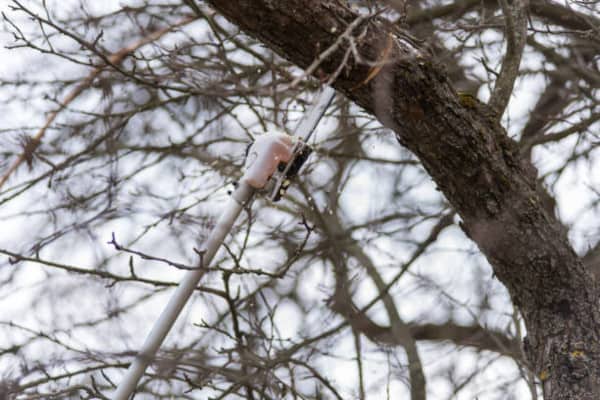In order to appear healthy and grow in a good shape, trees require occasional pruning to remove any broken branches and thin out any dense limbs. The best way to tackle this process is with a regular pruner or in case of large ill branches, even a chainsaw; however, problems arise when you have to deal with taller trees, as you cannot safely reach them with a chainsaw. This is when a pole saw comes into the picture; it allows you to reach up to tall branches and deal with them while staying on the ground.
What is a Pole Saw?
Just like other chainsaws, a pole saw is simply a saw that is made long enough to reach higher tree branches. There is no need for you to climb trees and put yourself at risk because a pole saw is an extendable and adjustable product. You can easily prune tall trees and cut dead branches quickly and efficiently without putting yourself in danger.
How To Choose The Best Pole Saw?
Buying the best pole saw entails you looking for certain features. To make a good purchase, some things that you must absolutely consider are:
Power or Manual Pole Saws
The first thing you need to know about pole saws is the different kinds available on the market. There are power pole saws and manual pole saws. Power pole saws can be further categorized into four different options: gas-powered, electric-powered (corded), battery-powered (cordless), and hydraulics.
Manual Pole Saw
Manual pole saws are incredibly reliable, especially when it comes to dealing with longer branches. These saws are commonly designed with long poles, providing them with a greater capacity to cut tall trees. Manual saws are easier to use due to their low weight, and they stand out due to the incredibly low price point they have than other types.
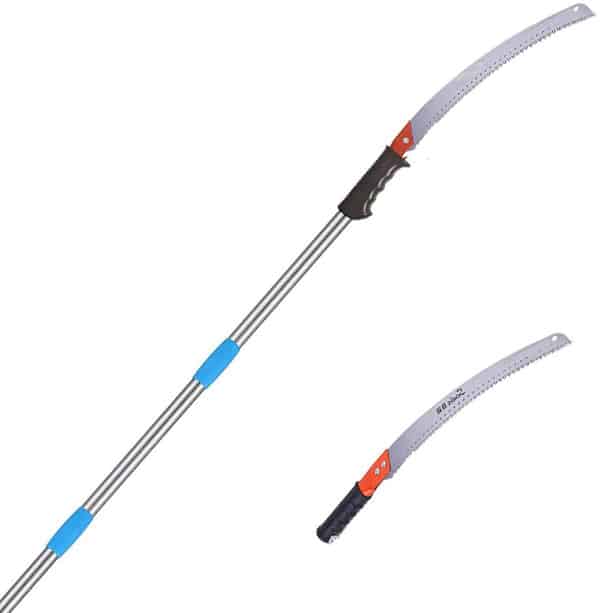
However, with the cheap price tag, you also have to deal with these saws’ slow cutting ability since you have to cut the branches and tree limbs one by one. Such pole saws require more time and effort, so if you have a limited budget and you can spend time on your trees, then a manual pole saw will make for the most suitable option.
Gas-Powered Pole Saw
If you need a pruning tool for heavy-duty services, then a gas-powered pole saw is the best option for you. This is the most powerful type of pole saw currently available and is designed for cutting thicker trunks and branches. A gas-powered pole saw is what most professionals tend to prefer and it is also what forestry and landscaping professionals tend to opt for.
Such pole saws can cut through thicker tree branches, usually those that are ten to twelve inches in diameter. The gas engine on these saws is very powerful and has improved torque along with comfort features such as rear-mounted engines and vibration reduction for better balance.
However, gas-powered pole saws are more expensive than any other kinds available in the market. They require refilling of gas whenever the tank gets empty, which adds to your gardening expenses. Also, this kind of saw is not ideal for small pruning jobs since it is louder and heavier. For this reason, gas-powered saws are only ideal for commercial and professional usage and for owners who own a large area.
Electric Powered Pole Saw
An electric-powered saw is the most common kind that consumers prefer. It is cheaper, easier to use, and not as heavy as other units present in the market. These kinds of pole saws are quieter when they are being used, and they can deal with branches that are 8 to 10 inches in diameter.
The corded feature makes electric-powered pole saws perfect for owners who have an average-sized property, but they are not ideal for heavy-duty usage. Some advantages of such electric-powered saws include low maintenance since they do not require you to change oil or refill the fuel tank. Lastly, they are lightweight and have budget-friendly prices as well.
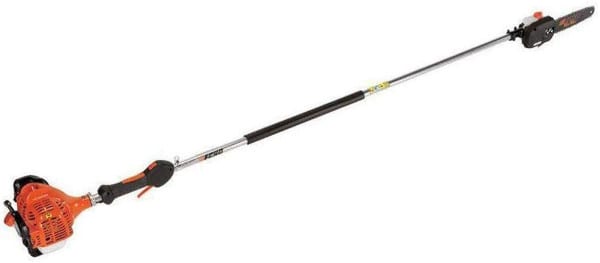
Corded vs. Cordless Pole Saw
Electric-powered pole saws draw their power from an electric outlet present nearby, so they need to be plugged when they are used. This means that you’ll have to stay within 100 feet of any electrical outlet, which is one of the major downsides of electric pole saws. Another downside is that the wire attached to these models can be disturbing and can get in your way when you’re carrying out pruning work.
Cordless pole saws are the most convenient type available in the market. With these products, wires and cords won’t be an issue at all since they are powered by a battery. Just like cordless pole saws, corded ones also cut through branches that are 8 to 10 inches in diameter. They are convenient and easily transportable, so you can use them whenever and wherever you want.
Cordless saws are very lightweight, and depending on the type of battery included, they can give a half-hour to an hour of usage from a single battery charge. Cordless pole saws are usually powered by lithium-ion batteries because they have a longer life span and provide a steady power output, even when the battery is draining. Ni-Cad batteries were used in these saws in the past, but they weren’t as effective as lithium-ion.
Even though these batteries have a steady power output, the amount of power cordless saws provide is the lowest as compared to the power provided by electric and gas-powered saws. But, in exchange for the low power output, corded pole saws offer portability, ease of use, and low maintenance. Some cordless units are rechargeable, so they will take time to charge up before you can use them. Meanwhile, some of them are powered through batteries only, which means that you’ll have to replace the batteries once they are depleted. If you want quick pruning and cleanup, then a cordless pole saw is a very convenient choice.
Hydraulic Pole Saws
Hydraulic pole saws are designed for people who work on roadside trees, forests, and big farms. This kind of saw is a very heavy-duty machine and comes with skid steer attachments. Hydraulic pole saws provide you with 50% faster and more accurate cuttings and are ten to fifteen percent lighter than most electric pole saws present in the market. A hydraulic pole saw is one of the best tools present in the market, and usually, it is installed on tractors and compatible skid steers.
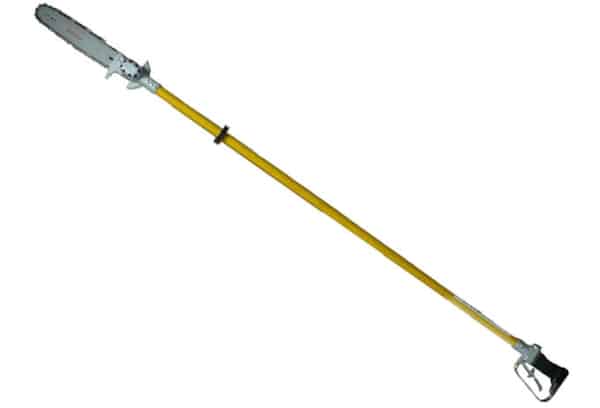
Pole Extension Length
The entire purpose of a pole saw is to reach higher tree branches. The pole length is one such feature that you find most variance in when you are shopping for a new pole saw. Poles come in different lengths and are designed from fiberglass or steel. Manual pole saws range from seven to fifteen feet and sometimes even longer. However, more recent models have telescoping poles along with an adjustable length. You can adjust these poles to your liking and lock them in to continue working, allowing you to work on trees with different heights.
However, one thing to keep an eye out for is that when manufacturers advertise the pole’s max reach, they represent how far the saw can reach when you hold it. This can be very misleading because when you look at poles closely, the maximum reach is not the pole’s maximum length. This maximum reach on the pole saw incorporates the pole’s max length and your arm length and not just the pole’s length. Make sure that the pole you buy is at least 7 feet long or more if it is a powered model.
Pole Saw Blade Size
The blade size or cutting bar length is another feature to focus on when choosing a good pole saw for pruning your trees. Usually, the blade size is expressed in inches, and it refers to the blade’s suitability to cut through thick branches. If you choose a manual pole saw, then a longer blade will allow you to cut large branches with less hustle and also give you more power efficiency with every pass of the blade.
On the other hand, when focusing on a powered pole saw, the exposed blade length tends to represent your maximum cutting extent. For example, if you opt for a seven-inch saw bar with six inches exposed, then you can only cut branches that are six inches or under with a single pass of the blade. To avoid this scenario, you must pick a blade length that is greater than the thickest branch you will cut through.
Pole Saw Weight
Another vital consideration that most buyers ignore is the weight of the pole saw. You should be able to move the pole saw from one point to the other; this portability is determined by the weight of the pole saw. Pole saws can become very exhausting to work with if the weight is high. Even though weight is a sign of stability, you still need to go for a lightweight pole saw that is controllable and can be handled safely.
Gas-powered pole saws are powerful and very efficient, but they are incredibly heavy. Try not to buy a heavy pole saw, no matter how budget-friendly it is, because you will not be able to move it around, so it won’t be worth your money.
Maintenance
When it comes to maintenance, you will need to focus on how often the pole saw will be used and then maintain it accordingly. Generally, gas-powered poles need more maintenance than battery or electric-powered ones. With these pole saws, you need to carry out daily tasks such as changing the air filter to keep them in top-notch working conditions. For occasional use at home, electric and cordless models are more efficient, and you need to make sure that their chain is kept sharp.
Additional Features
One other feature to look out for is noise. If you live in a close and quiet community, then you must avoid gas-powered pole saws as they are very loud and noisy. Cordless, electric and hydraulic models are quieter and won’t disturb your neighbors.
Furthermore, additional features in the pole saw makes it worth investing in. These features can include safety switches, ergonomic grips, removable poles, automatic chain lube method, easy-to-adjust saw bar angles and more.
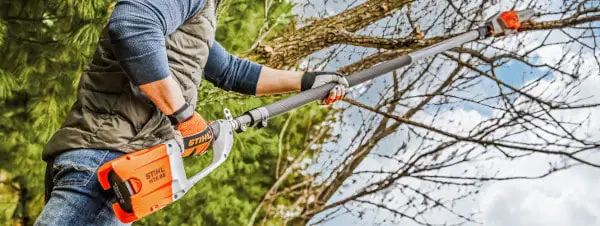
How Much Does a Pole Saw Cost?
Just like every other product in the market, pole saws have different price points as well. You can find cheap saws that are under $100 and expensive ones that are around $300 and more. If you are a beginner, then you can opt for a low-cost electric pole saw since it will provide you with the effectiveness you need at a lower price. However, if you have money to spend, then you can opt for a gas-powered pole saw since it is very powerful.
Are Pole Saws Safer Than Chainsaws?
Pole saws are safer than chainsaws because of their design. Pole saws have the blade at the tip of the pole, which makes them safe to use because the blade will not be near you. Meanwhile, chainsaws are handheld, so in case of a slip or a mistake, it can cause harm to you or anyone near you.
Conclusion
A pole saw is a great tool to use to deal with excessive tree growth in your home. It comes in different shapes, sizes, and power options, so when choosing the pole saw ideal for you, you must buy one that fits your needs.


